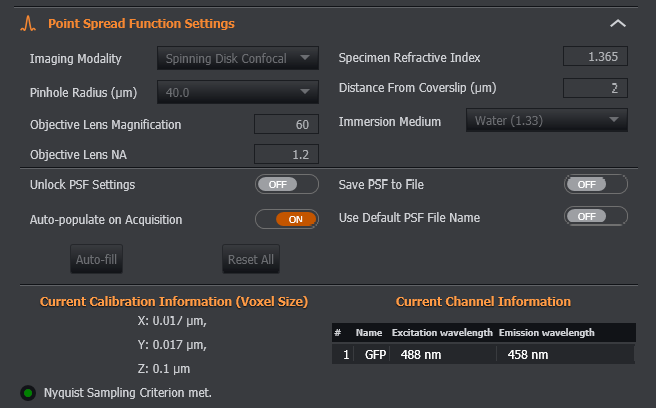Point Spread Function
Fusion uses a fast integrator to accelerate the Gibson-Lanni algorithm, used to estimate a robust 3D PSF, with aberrations.
This is the best algorithm available today for PSF estimation.
Point Spread Function Settings

Note: PSF settings must be unlocked before editing the default values. These settings will usually be automatically filled if the image has been acquired on a compatible system.
Imaging Modality: Set the Imaging mode used to obtain the deconvoluted image. The following options are available:
- Spinning Disk Confocal
- Widefield Fluorescence
- Brightfield
- Laser Scanning Confocal
- TIRF
Pinhole Radius: Set the appropriate pinhole radius from the drop-down list.
Objective Lens Magnification: Set the magnification for the objective.
Objective Lens NA: Set the Numerical Aperture of the Objective Lens (valid values range from 0.2 to 5.0).
Specimen Refractive Index: Set the refractive index for the specimen. The default value is estimated. This can be updated if an exact value is known for the specific specimen. Valid values range from 1.0 to 5.0.
Distance From Coverslip: Acquisition distance from the coverslip. This is used to estimate point spread function form. The default value is the central Z plane of the image stack assuming starting position is at the coverslip and is determined by the calibration values in the image. This value can be updated if the exact figure is known.
Immersion Medium: The refractive index for the Objective Lens immersion medium. The following options are available:
- Air (1.0)
- Oil (1.52)
- Water (1.33)
- Glycerol (1.46)
- Silicone Oil (1.40)
- Custom (enter a custom value. Valid values range from 1.0 to 2.0).
Unlock PSF Settings: Unlock the PSF settings to enable values to be adjusted from the default values. Default OFF.
Auto-populate on Acquisition: Auto-populate PSF settings for acquired images using device information at time of acquisition. Default ON. (Note calibration information shall always be updated regardless of this option).
Auto-fill: Automatically fill current invalid fields with a previously held valid value (if a valid value has been entered previously)
Reset All: Reset all values to the default values.
Save PSF to file: Save all PSF data generated during deconvolution processing to a .ims file. The name of the .ims file is automatically based on the name of the input file to be deconvolved. Default OFF.
Use Default PSF File Name: Use a default file name when generating PSF data via the Generate PSF button in the ClearView panel (otherwise an input name is required from the user in each case). Default OFF.
Current Calibration Information: Shows the calibration information (voxel size in each dimension) for the current image. Includes a Nyquist Sampling Criterion check.
Current Channel Information: Shows the channel information for the current image, including Name and the Excitation and Emission wavelengths for each channel.